James Clinton
John McKenna
John was a true son of Boston, and lived his adult life in the South End. He was a man of action whose life was rooted in fairness and justice, and who found a kindred spirit in his wife of 49 years, Kathe.
When they saw homeless sleeping in doorways in the South End in the mid 1960’s, they provided hospitality, inviting them to sleep in their living room. When the need to feed, clothe and shelter the homeless exceeded the space in their apartment on Upton Street, together with like-minded friends they purchased 23 Dartmouth Street and founded Haley House of Hospitality.
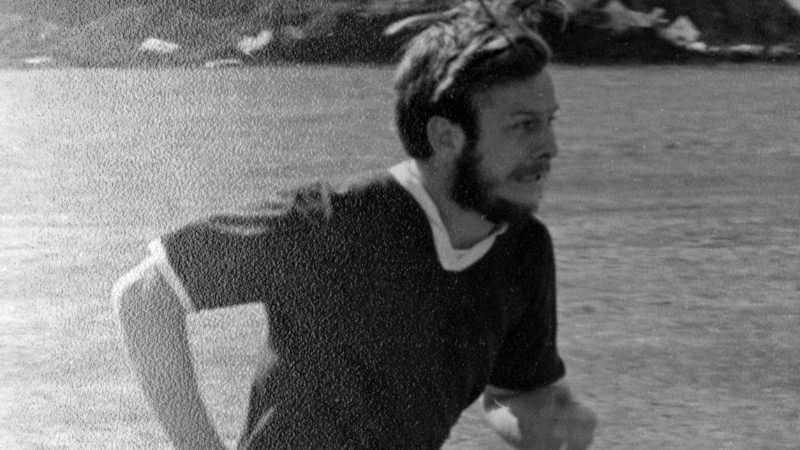
The new non-profit now had a home, but it also had bills, so John– with pick and shovel in hand –dug graves at Brook Farm cemetery, giving his paycheck to Haley House. Founded as a simple Catholic Worker Soup Kitchen, Haley House currently serves homeless and marginalized individuals in 100+ units of affordable housing in the South End and two social enterprises in Roxbury: Haley House Bakery Café and Dudley Dough.
While a student at Holy Cross College, and under the threat of expulsion, he joined Dr. Martin Luther King’s 1965 Civil Rights March from Selma to Montgomery. Hosted by an African-American host family, John was picked up by the police on his way to the Edmund Pettus Bridge and locked in a bus with other potential marchers to prevent their participation.
John and Kathe honeymooned on James Meredith’s “March Against Fear.” His responsibility was to walk the perimeter to intervene with night-riders. John also took a firm stance against the war in Vietnam, registering as a conscientious objector in 1967. He was jailed in 1968 and 1969 for his participation in anti-war demonstrations.
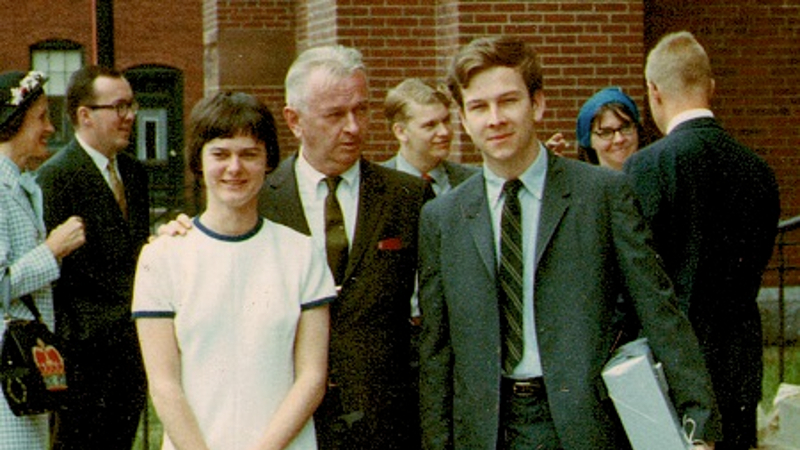
In order to support his family, John became an MBTA police officer. He would serve for 20 years and eventually become head of the patrolmen’s association. While on the force he put himself through law school. Stoop-sitting, a South End tradition is for most an opportunity to enjoy a quiet place to chat. But for John the stoop was also his study hall. After his overnight MBTA shift, John could be found on his steps, law books in hand, preparing for class at Suffolk Law School. The method worked well, as he passed the bar on his first try and practiced law for the next 14 years. Gov. Weld appointed him to an administrative law judgeship in 1992.
John eventually went back to providing direct care to homeless individuals and families at Pine Street Inn and Sojourner House. For more than 20 years, John also served as an officer and board member for COMPASS, where his wisdom and integrity helped guide and grow the small special-education school into a multi-service organization assisting at-risk youth and families throughout Boston as well as a dozen other areas in Massachusetts.
John was also a fierce athlete. Be it rugby in Somerville, squash in Roxbury, softball in Brighton or a run around Castle Island, there was no need for stretching or warming up, for there was a game to be played. Unfortunately, his whole-hearted participation in rugged sports would significantly diminish his health later in life.
With multiple jobs and four daughters, John was not one to rest. His girls once posted a cartoon on their refrigerator entitled “Dad on Vacation.” It depicted a man watching a vacation scene on TV.
In sum, John was a humble hero — not only to family and friends, but to countless souls whose lives he enriched immeasurably through his tireless efforts. There will be many, in years still to come, who will benefit from his accomplishments without ever knowing his name.
Steve Murra

This is the story of my husband, Steve Murra, “bigger than life” dad, husband, coach, and person.
Steve and I met two days before my freshman year of high school. I had just moved to Iowa Falls, Iowa and Steve, who was a junior at the time, had lived there his whole life. We quickly became friends through our involvement in our church youth group. Two years later, Steve shared with me that he had wanted to date me since he met me and I felt the same. We became inseparable, the couple everyone knew and wanted to be – it was always Steve and Jennifer – never one without the other. We were married in 1993, still both in college.
Steve had started playing rugby at age 17 and played for 20+ years, for the local Iowa Falls Rugby Club where his dad was the longtime coach. His passion for rugby developed quickly and he became highly involved in the sport at many levels. He was a student of the game and loved every second of being on the rugby pitch.

In 1994, Steve was asked to start a women’s rugby team at the University of Northern Iowa. Little did we know this would be the beginning of what would define our lives for the next 21 years. Steve began coaching and quickly grew a strong program. He had an uncanny ability to teach rugby to anyone. His players played with their heart and soul and always wanted to make him proud. He believed coaching was not just about teaching the sport, but also about helping his players grow as people and learn to be strong women. I started out managing the team and then became his assistant coach – we did everything rugby together. Highly successful as a coach, Steve not only had fun coaching, but made it fun for the team, all while instilling a desire to win. Steve’s coaching record was strong with an overall record at UNI of 350-51. He coached many players who rose to be highly successful including 3 USA Senior Women’s Eagles & World Cup players, 9 USA U23 Women’s Eagles, 6 1st Team All Americans, and countless players who advanced to local and regional All Star Teams.
Steve was also the Head Coach for the U23 Women’s Midwest Thunderbirds, an All-Star Team encompassing nine states. He won a National Title coaching that team and went on to take the team on international tours for the past few years.

Our first child, a daughter was born in 2001 and she began traveling with us to rugby events. When our son was born in 2006, he traveled to Penn State for Nationals with us when he was 5 days old. Rugby was our life and it was our family’s life.
Steve was an amazing, loving, caring person who always saw the best in people and always gave everyone a chance. He had a way of making every person he met feel special and accepted. He knew no strangers and made friends everywhere we went. He truly impacted the lives of every person he knew. Steve was hilarious and could make any story sound interesting and typically took over any room he entered. He taught American History at a community college and was a favorite instructor at the school because he made the class fun and interesting at the same time. His passion for teaching and coaching was obvious to anyone who observed him or talked to him about those subjects. Steve was simply a beautiful person.

Through it all, the number one thing in Steve’s life was his family, especially his kids. Steve’s schedule allowed him to spend a great deal of time with his children. He was well known at the kid’s school volunteering for various things and always went on school field trips. He was involved with all the sports in which our kids participated, coaching our son’s flag football team and being the head timer for our daughter’s swim meets. He was an exceptional father and loved his children more than anything.
It is truly difficult to find a way to describe Steve, this bigger than life person. Words that come to mind are: carefree, uninhibited, daring, non-judgmental, unconventional, laid back, calm, funny, adventurous, loyal, accepting, pioneering, determined, witty, generous, smart, women’s rights advocate, compassionate, charming, stylish, thirsty for knowledge, father, friend, and teammate.
Unfortunately, Steve’s personality slowly started to change. I didn’t realize at the time how things were slowly slipping away, but now looking back I can see it clearly. The person who once had unending patience, had a shorter and shorter fuse. The person who was happy and laid back, became angry and uptight. There were long periods of normal behavior and short periods of the angry, unhappy person which slowly turned to short periods of normal behavior and long periods of him being a person I did not recognize. As time wore on, the anger worsened and began to impact most areas of his life. Steve complained of headaches often and took a great deal of ibuprofen. I had countless conversations with him over a period of many years, begging him to get help, asking him what was wrong and why he was so different. He always told me, there was nothing wrong or that he was working on trying to make changes. I never saw those changes other than small windows of days when he seemed a bit better.
Steve’s behavior spiraled downward over the course of the last year of his life, very quickly. He chose to retire from coaching at UNI in January 2015 and things spiraled even quicker after that. He went on his last tour overseas in August 2015. During the Fall of 2015, his behavior worsened and he started abusing alcohol. By that point, he was angry most of the time, had become paranoid, and was putting me down to our kids. I discovered he had stopped paying our bills and when I asked him why, his only response was “I don’t know”. In January 2016, I made the hardest decision I ever had to make in my life and asked him to move out of our house because I could no longer tolerate his behavior toward me or the kids. I begged him to seek counseling and make changes so he could come back home.
Never in a million years did I ever think I would ask this person who was so amazing and my best friend, to leave our house. We always planned to grow old together.
Steve always had a special relationship with my parents. He lived with them while I was in college and had nowhere else to live. My parents considered him their son. When I asked Steve to move out, my parents agreed to let him stay there until he could find a place of his own.

Steve died by suicide on February 20, 2016. Regardless of how far he had spiraled, I never thought he would ever do something that would hurt me and the kids so much. This was not behavior anyone would ever expect of the Steve they knew. The news of Steve’s death sent shock waves through the rugby community and our home community. This was a person who loved life and tried to make the most of every day. Unfortunately, my parents were the ones who found him. Their lives will never be the same. My kids won’t go to their grandparent’s house anymore, a place where they previously spent a great deal of time.
As his behavior was worsening, the possibility of CTE came to mind given his years of playing rugby. Steve never had a diagnosed concussion. When I was notified of his death by the medical examiner, I asked that his brain be tested for CTE because Steve taking his life made no sense for his personality.
I truly believe Steve tried his best to get well, but ultimately he knew there was something wrong with him that couldn’t be cured. Now I know, he really couldn’t answer my questions about why his behavior was changing, he really didn’t have the ability to answer.
On November 10, I received the results of the CTE testing and was told Steve had Stage II CTE. I felt so sad for him having to suffer, but I also felt relief at having an explanation as to how this person who I had loved so much and had been with for 28 years changed into a person I didn’t know.
Suicide always has far reaching ramifications. People blame themselves for the person’s death and try to figure out the answer to why. This diagnosis has allowed me to explain to my kids that their dad’s suicide was not because of anyone, it was because he was sick and couldn’t make sense in his head anymore. So many families never get this information and forever wonder why. We have an answer, we have some peace, we miss him every day.
Read coverage of Steve’s story and CTE diagnosis in the Times Citizen.
Rowan Stringer
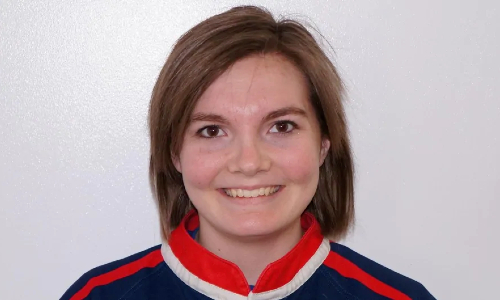
Rowan was 17 years old and in Grade 12 (Senior) when she passed away following a concussion received during a rugby match for her high school team. A Coroners Inquest into her death held in May of 2013 concluded that she died from Second Impact Syndrome and had likely suffered two previous concussions in two games during the five days preceding the match where she suffered the fatal injury.
Rowan was captain of her high school team and also played for the Barrhaven Scottish RFC. She played ringette, soccer, flag football, lacrosse and was also a keen snowboarder. She had been accepted into Ottawa University to study to become a Registered Nurse.
Her death and the results of the Inquest spurred her family to campaign for “Rowan’s Law” in Ontario. The law, the first of it’s kind in Canada, came in to force on September 9, 2016.
Barry “Tizza” Taylor
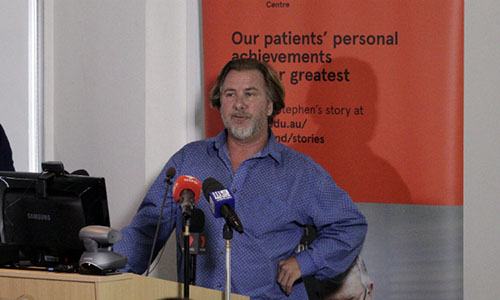
On March 24, 2018, Steven Taylor, the son of legendary Australian rugby player and coach Barry “Tizza” Taylor, spoke at the launch of the Australian Sports Brain Bank in Sydney, Australia. His father’s Chronic Traumatic Encephalopathy (CTE) diagnosis, made by researchers at the UNITE Brain Bank in 2014, was considered a “wake-up call” for the Australian sports community. Steven spoke of his father’s glory years, how the degenerative brain disease affected him, and what his father’s legacy will be. Below is the transcript of Steven Taylor’s speech:
Steven Taylor talking about his father’s Legacy.
Over 4 years ago, I was sitting on a lounge with Dr. Ann McKee in a Conference Centre in Richmond, Virginia and she said, “I’ve held your father’s brain in my hands.” To which I replied, “I think you’re the first person that’s ever said that to me!”
A brief history of Barry Taylor
The son of an Australian Champion Boxer, living in the working class of Glebe, Dad was brought up tough… and to be tough. At 8-years-old the family moved to Manly where he became involved in swimming. He had a natural talent for sport, coupled with a strong will and in a few years, he would become a NSW and Australian Champion in Surf Life Saving.
In winter though, it was Rugby Union. He played 325 Grade games for Manly and, although he wasn’t the biggest guy on the field, he was one of the toughest, and took great pride in getting straight back into the game after a big hit. And I’m told he took quite a few.
His ability to rally and motivate people led him onto his coaching career. It was his passion, and he was good at it. He always coached the same way he played: tough. His ability to read the strategies and psychology of the game of Rugby Union and win games led him on to Coach Manly, the NSW Waratahs, the Australian Under 21’s and then on to coach internationally in Western Samoa, Japan, England and Uruguay.
Towards the end of this time overseas, Dad, in his late 50’s, began to show signs of abnormal behavior. Mum, who was always at his side, had to start covering for him. We didn’t realize that these were the first signs of dementia. After some challenging times, they returned to Australia and the madness began.
Living with CTE
So, I’m going to ask you a question. Think back to 1999. Where were you? What were you doing?
Today it is 2018. That’s 19 years, right? That’s how long Dad’s illness was. Who knows, it may have been longer. How do I try to explain what it’s like to live with someone with CTE and squash all those years into a few minutes? I’ll try.
Those of you who have experienced dementia with a loved one will have an idea of the roller coaster ride of craziness. There is no rhyme or reason to it. It moves and changes continuously, the only thing that remains constant is the steady decline, which, in dad’s case seemed to drop, then plateau for a while, drop again, then plateau, then drop, etc, etc. Sanity goes out the window, it’s confusing, frustrating, harrowing, frightening, destructive, illogical and extremely difficult to carry out a normal life. And the repetitive questions… relentless. The worrying, he must have asked Mum at least 40-50 times every night if all the lights were off, there’s no fun in it. No fun at all. Just when you thought you were on top of managing Dad’s madness, it would take off in another direction.
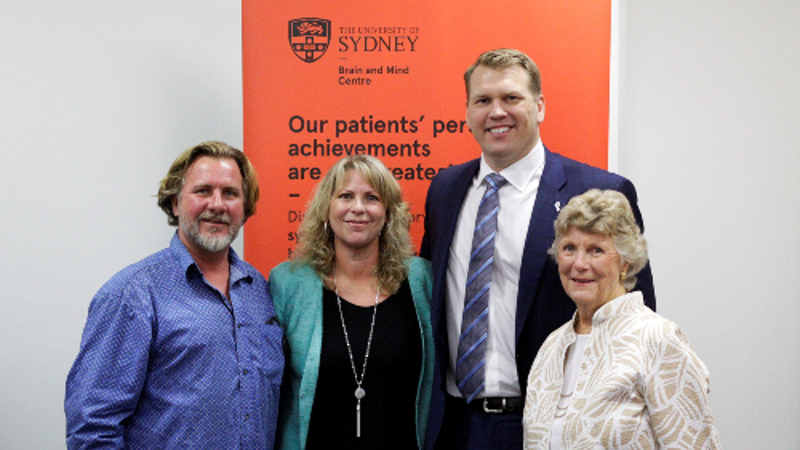
The Taylor family at the launch of the Australian Sports Brain Bank in March 2018.
In the beginning, it was fairly normal forgetfulness: Where are the car keys? Where did I park the car? Losing directions to somewhere he had been a thousand times, forgetting people’s names. Then the anger. Explosive moments of irrational anger, him wanting to fight, I suppose it was the internal frustration he must have felt, knowing that there was something terribly wrong going on in his mind. Dad never spoke much about his emotions even when he was well, and we never, ever spoke about it throughout his illness. Then it started getting scary. His aggression was spiraling. On one occasion we got into an argument — I can’t remember what it was about – and he had me up against a wall, with his fist clenched in a fit of rage. His eyes were crazy. This wasn’t my Dad! There were plenty of times as a young fella when I probably deserved a proper belting, but this was just craziness, it was the illness…
Fortunately, I was able to pull him down to the ground and just hold him until he calmed down. Luckily neither of us suffered any great injury. Very, very disturbing stuff. This happened more than once. So with the madness at its peak, we spoke with his GP (general practitioner) who diagnosed him with Alzheimer’s and began drug management. For some reason I didn’t think it was Alzheimer’s… I’m not sure why. One symptom of his illness at this point was paranoia; he wouldn’t take any pills because he thought we were trying to kill him. So, the doctor prescribed a drug in liquid form so it could be put in his food or a glass of water. Can you imagine having to do that?
But these drugs were way too heavy, we felt awful to see him so drugged so we set out to find a solution. Eventually we found the right balance of anti-psychotics and anti-depressants to try to give him some quality of life.
With Mum as his full time career and my sister Jenny and I doing our best to help out, the next few years were still extremely challenging and at times we were all pushed to our limits. Jenny was struggling with raising her two babies and trying to help out with caring for Dad and I unfortunately slipped into depression, which really wasn’t much help to anyone and it’s a battle that I still fight to this day. And Jenny and I have spoken since then about our own fears: Are we going to get this too? But at least Dad was now somewhat manageable, he was quite happy in his favorite chair and enjoyed short walks and drives in the car with Mum. But of course, the illness continued on its decline and eventually he lost control of his bodily functions. It was time for him to go into professional care; there was no way that Mum could possibly care for him at home any longer. She had, in my opinion, performed superhuman feats in caring for Dad and holding our family together, but it had taken its toll on her, she was mentally and physically exhausted.
We were lucky with the facility we found for Dad. Not only were the staff kind and considerate with him, they were also there for us as a family. Visiting him there was heartbreaking to say the least and the heavy feeling of guilt every time you left never got any easier. One day when I was visiting, I knew that he had already forgotten who I was, so out of curiosity I asked him what his name was.
He just looked at me and shrugged.
That’s how bad it got, he literally didn’t even know his own name. Part of the tragedy, is that his fearlessness and the physical contest of the sport he loved deprived him of a dignified old age and his family and friends of someone whom they loved. One night we got a call from the nursing home. He had finally passed away. He was 77 years old.
Closing
Peter (FitzSimons) spoke with Mum a couple of days later and after offering his condolences asked if the family would consider donating Dad’s brain to Boston University for research into CTE. We said “yes.” Dad had never been to Boston so it seemed like a good idea. As a family we are incredibly grateful to everyone involved who made it possible for Dad’s brain to make its incredible journey. It wasn’t easy, with many hurdles, but somehow it all happened. A year or so later we were invited to the Inaugural Family Huddle, a conference put on by the [Concussion Legacy Foundation] for all the families who had donated their loved one’s brains. It was fascinating to learn about the research by this wonderfully dedicated team of people into CTE, and surprisingly comforting to be amongst a group of strangers who had all been through similar experiences that we had. Swapping stories that night was such a healing experience, that we were not the only family that had gone through the horror of living with a loved one with CTE.
At the end of the evening, there I was on that lounge with Dr. Ann McKee, who performed the dissection and analysis on Dad’s brain. After telling me that she had held my father’s brain in her hands, she looked at me very compassionately and said, “I don’t know how he was functioning on any level at all, I can only imagine what you went through as a family.” I asked her if there were any markers of Alzheimer’s in her testings. She shook her head and said, “No, it was emphatically CTE that killed your father.” Finally, we had an answer to our years of questioning. Finally, we had closure.
So, we, the Taylor family, are very excited and hopeful that the Australian Sports Brain Bank will be a great success. We would like to congratulate all the people here who have worked so hard to set it up, and hope that research that can be carried out right here at home will lead to not only changes across all the sporting codes in regards to concussion, but more importantly, may lead to the ability to diagnose CTE in living patients. Perhaps then we can even find ways to treat this disease to prevent other families from going through the nightmare that we had to endure. Thank you.
To read Peter FitzSimons’ story of helping get his former coach’s brain donated after Barry Taylor died in 2013, click here.